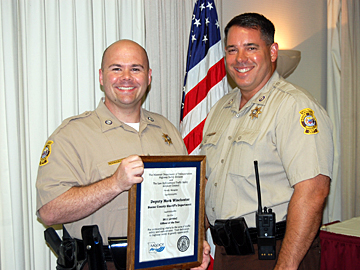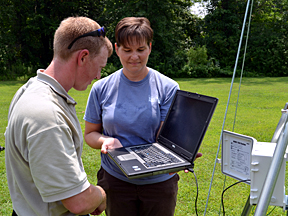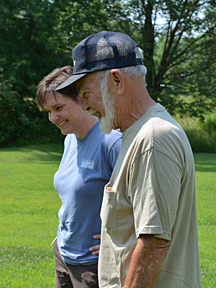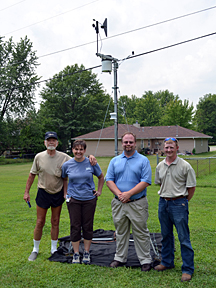Boone County News Release
For Immediate Release
Media Contact:
Boone County Commission Administrative Coordinator
Phone: (573) 886-4312
Boone County Week In Review
July 15, 2011
For the week ending July 15, 2011
Things you may have missed...
Winchester named Officer of the Year

Deputy Mark Winchester, left, and Sheriff Dwayne Carey
A veteran Boone County sheriff's deputy was recognized Thursday, July 14, by the Law Enforcement Traffic Safety Advisory Council (LETSAC) as its Large Department 2011 Officer of the Year at the agency's annual conference in Lake Ozark.
Deputy Mark Winchester, 33, is assigned to the department's traffic unit and last year made 222 arrests for Driving While Intoxicated in Boone County. Deputy Winchester has been with the department since 2003 and is a certified Field Sobriety Test Instructor, Drug Recognition Expert Instructor and Accident Reconstructionist. The "Large Department" category is considered a law enforcement agency in the state of Missouri that has at least 40 sworn officers.
"We're all very proud of Deputy Winchester," said Sheriff Dwayne Carey. "He is totally committed to removing impaired drivers from the roadways of Boone County and making the community a safer place."
About 250 law enforcement officers from Missouri attended the LETSAC Conference. This year's training emphasized identifying various drugs that impair driving, rolling methamphetamine labs, roadside safety, commercial vehicle inspection, legal issues and accident reconstruction.
This year's conference was sponsored by the Missouri Department of Transportation and the Missouri Safety Center.
Tom O'Sullivan, Sheriff's Department
Boone County places in top 10 counties providing digital services
Boone County has placed in the top 10 among counties with a population from 150,000 to 249,999 in the 2011 Digital Counties Survey. The Digital Counties Survey recognizes leading examples of counties using information and communications technology. The Center for Digital Government and Digital Communities program, in partnership with the National Association of Counties (NACo), identifies best electronic practices among counties nationwide, regardless of size.
"As far as supplying data to citizens, I think we go above and beyond most counties, especially supplying live data via our website," said Aron Gish, director of the Department of Information Technology with Boone County. "It's the real data. Our data feeds are not from a data warehouse, they are not a copy from overnight -- it's live data. When you make it to our website and use our data, you're using the same data that the Collector is working with in their office. If you want to check that your taxes are paid, you can walk away from the window, look it up via our website applications and you're going to see your taxes are marked paid."
"The Digital Counties Survey identifies the very best examples of how counties are aligning technology to support strategic priorities and create crucial operational and administrative efficiencies," said NACo Executive Director Larry E. Naake. "Especially important during these tough economic times, counties across the country are using innovative technologies to reduce county operations costs and enhance service delivery."
According to James Barnes, Web developer with Boone County, the County regularly places in the top 10 of the survey, even though the County's growth over the last decade has pushed it into a different category of the competition. "This is the second year that we're in a new category that's driven by population," Barnes said. The County moved up to the 150,000 to 249,999 population category in 2010.
"It's been beneficial," Gish said. "Internally, it kind of drives us, gives us a little bit of direction on what's coming, the way information sharing is changing."
In addition to the Digital Counties Survey, Gish said that the Center provides its members with access to online forums, educational opportunities and information exchange. One of the best benefits, according to Gish, is the ability it gives the County to compare its developments in IT with its peers. "One of the best things about it is that we get to see what other counties are doing. We get to see what other counties and cities are offering their citizens as far as access to public information."
Boone County tied for ninth place with St. Tammany Parish, La., in this year's survey.
Lamar Henderson, Public Information
Stormwater control project begins in Sunrise Estates
Sunrise Estates has a stormwater problem — a pretty significant stormwater problem, and one that has plagued the neighborhood since it was built.
“This problem has been going on since the early ’60s when this subdivision was started,” said Bob Tripp, president of the Sunrise Estates Homeowners Association. He said that, when the subdivision began, there was no planning to deal with excessive stormwater. “Nobody worried about that. When they started excavating for a new home, nothing was done to protect from the run off, or anything else. There were no plans set forth as far as drainage was concerned.”
Sunrise Estates resident Mel Casteel agreed that stormwater is a problem in the area. “It’s bad and it’s always been bad. Water will stand in people’s yards.” Casteel said that there have been efforts during the more than 15 years he has lived in the neighborhood to deal with the issue, but questioned their effectiveness. “What the county has done the last few years that I’ve seen — whether it’s good or bad — they’ve put bigger culverts in. Well, that makes more water flow, and flow faster. And that was a good thing to do, but they didn’t do anything to take care of the increased water flow.”

Boone County Stormwater Coordinator Georganne Bowman (right) works with Geosyntec Consultants technician Nick Muenks to set up a climate station in Sunrise Estates
It was the neighborhood’s water issues, plus that fact that it is located on its own miniature watershed, that attracted Georganne Bowman to Sunrise Estates. Bowman is the Stormwater Coordinator with Boone County, and she found that Sunrise Estates, located in Boone County just east of Columbia, would be an ideal environment in which to conduct an experiment testing different methods of ameliorating problems created by excessive stormwater run off.
“We are using this because it’s a closed watershed — a little one, but we can use this information to extrapolate to larger watersheds,” Bowman said. “Granted, this is much, much smaller than the Hinkson, but we can use this for areas like Flat Branch, or maybe Meredith Branch. So, we can figure out that, to actually see a decrease in stream flow during a significant event, we need to put in this many rain gardens, or this many square feet of treatment features. We’ll use this as a tool to model other watersheds.”
To start off the project, Bowman has installed an electronic climate station in the neighborhood. The equipment, a Hobo U30 Station manufactured by Onset Computer Corporation, measures several environmental phenomena, including the intensity, duration and amount of rainfall, wind speed and direction, relative humidity, temperature and the amount of solar radiation falling on the area. The data gathered by the station are then transmitted to a website, where they will be viewable to the public. Also being installed is a weir to measure the amount of water than drains from the watershed.

Boone County Stormwater Coordinator Georganne Bowman (left) observes progress on the installation of the climate station with Sunrise Estates Homeowners Association President Bob Tripp
The purpose of the climate station, Bowman said, is to measure how effective different methods designed to slow the run off of stormwater are, primarily rain gardens.
“Do rain gardens work? That’s one of the big questions we’ve had locally,” Bowman said. One problem with using rain gardens to deal with water run off is that they can slow the water flow too much, creating breeding grounds for mosquitoes. “We’re trying to figure out ways to modify those so they drain slowly, so you’re extending that peak of the flow to the stream. You’re not getting it all flushing through right after the rainfall event.”
Bowman said that the project will be installing three different types of rain gardens, and will monitor them to determine what kinds of plants work best in the local climate and soils, as well as which plants are more likely to be maintained properly by the residents who install them.
One goal of the project is to focus on developing best practices for using rain gardens and other techniques to control stormwater, rather than simply installing the gardens. “All over the country, rain gardens are a big endeavor — Kansas City has this 10,000 Rain Gardens project — the problem being that when you do a shotgun approach, you’re not getting a lot of bang for your buck. So, my hope is to really concentrate that in this small area and try to put in as many as we possibly can and see where that tipping point is. 'When we put in five, do we see any difference? No. What about when we put in 17 — oh, there’s a little bit of difference in the stream flow.’ With the climate station and the weir, we should be able to mark that change.”
In addition to rain gardens, the project will also install other treatment features such as rain barrels, and also perform some stream rehabilitation and stabilization projects. The project will also be planting 60 to 75 trees. “We’ll be doing a wide variety. We’ll probably try to target more wetlands species — swamp white oak, cypress, that kind of thing — so we can plant those in areas that are known to have water problems right now, try to get those trees to transpire and move some of that water out of that watershed.”

From left: Bob Tripp, President of the Sunrise Estates Homeowners Association; Georganne Bowman, Boone County Stormwater Coordinator; Chris Zell and Nick Muenks, Geosyntec Consultants technicians
The three-year project in Sunrise Estates is being funded by a grant from the Environmental Protection Agency, passed through the Missouri Department of Natural Resources. The grant requires 40 percent matching funds, which are being provided primary in the form of services and personnel time provided by the project participants.
A lot of people had to come together in order to make this project happen, according to Bowman. In addition to Boone County and the Sunrise Estates Homeowners Association, participants include the City of Columbia, the Missouri River Community Network, AmeriCorps, Job Point, the Missouri Society of Professional Engineers, the Missouri Association of Professional Soil Scientists, the Missouri Department of Conservation, the University of Missouri and the Missouri Department of Natural Resources.
Both Casteel and Tripp expressed enthusiasm for having the project starting in Sunrise Estates and hope that it would alleviate some of the area’s water problems. “Hopefully, this will address those issues,” Casteel said. “That’s why they’re looking at putting it here in this neighborhood, and certainly why we want it here in this neighborhood, because we do have water problems.”
Tripp said that the homeowners association hoped the project would assist in its efforts to improve conditions in the neighborhood. “These rain gardens appear to be something that’s going to be very pretty, once we get some of them put in, and the configuration of them, I believe, is going to help the flow situation,” Tripp said. “We’ll find out if it’s a day late and a dollar short.”
Lamar Henderson, Public Information
Subsidized housing update
A case arising out of Butler County and now before the Southern District of the Missouri Court of Appeals has the potential for changing the way assessors value subsidized housing. This case* pertains to a low income housing complex (40 units, community room, and office) subject to restrictive agreements with the Missouri Housing Development Commission. The apartments were built in 2006 for over $4 million and the State Tax Commission, using the Maryville Properties formula developed to value such property, determined a value of $888,300.
In the late 1990s, the State Tax Commission's valuation of subsidized housing attributed some value to the accompanying tax credits. In Maryville Properties v. Nelson, 83 S.W.3d 608 (W.D.Mo 2002) the Western District of the Missouri Court of Appeals ruled that the value of tax credits were not to be included because they were intangibles. Subsequently, after considering the benefits and risks associated with subsidized housing, the State Tax Commission determined that calculating value based upon actual income, actual expenses, and actual interest and capitalization rates was the best way to recognize all benefits and risks associated with subsidized housing.
In the Poplar Bluff Associates decision, the Commission said:
In Lake Ozark Village v. Whitworth, the Commission stated: In this case, and all subsequent subsidized housing cases, the correct methodology for valuing subsidized housing projects is the methodology set out in Maryville Properties. That methodology is accurate because (1) rent restrictions are considered through the use of actual income rather than market income; (2) additional management requirements and expenses are accounted for through use of actual expenses which are in excess of market expenses; and (3) the actual loan-to-value ratio and the subsidized interest rate demonstrates and accounts for any and all risks involved in the property as well as the benefits flowing to the property. It is "economic reality."
The Butler County Circuit Court disagreed. The Poplar Bluff Associates v. Tibbs decision held that using actual income and expenses rather than the market income and expenses while other apartment complexes used market data creates a lack of uniformity and a prohibited fourth subclass of real property. The court, citing Snider v. Casino Aztar, also indicated that the cost approach for the relatively new facility could have been utilized. Essentially, according to the court, the low income housing should be valued similarly to other apartment complexes.
On May 26, 2011, the taxpayer appealed the circuit court decision. As a consequence of this case now pending in the Southern District Court of Appeals, the State Tax Commission will stay all current and future appeals concerning subsidized housing properties until a final decision is rendered.
* Captioned at the circuit court as Tibbs v. Poplar Bluff Associates I, Butler County Circuit Court, No. 09BT-CV02672, and at the State Tax Commission as Poplar Bluff Estates v. Tibbs, Butler County, STC # 07-45502.
Missouri State Tax Commission, memorandum dated June 30, 2011
There's still time to give blood at the OEM/Red Cross blood drive at Government Center
Did you know there is an American Red Cross blood drive this week? And if you donate, you will be entered to possibly win a $250 gas card?
The Office of Emergency Management and the Mid-Missouri American Red Cross are teaming up for this blood drive! The drive will be at the:
Boone County Government Center
Commission Chambers
Friday, July 15
11 a.m. - 4 p.m.
801 E. Walnut
All blood types are needed -- especially type O negative during the summer months!
If you have any questions, please contact the Red Cross at 573-489-2450.
Won't you please join us and give the gift of life?
Zim Schwartz, Office of Emergency Management
Job opportunities
Boone County Human Resources is currently accepting applications for: Corrections Officer, and Deputy Sheriff - Roster Eligibility Only. For more details about these positions, or to apply, please visit www.showmeboone.com/hr.
Kara Coustry, Human Resources
In the news
Sheriff's office competes in biggest loser challenge
Members of the Boone County Sheriff's Department are not only cracking down on crime these days, they are battling body fat. | KRCG-TV
Tourism, hospitality industries see slow-but-steady growth
Tourism and hospitality industries in Boone County are seeing a brighter fiscal future after enduring a prolonged economic recession. | Columbia Business Times
Have an item for Week in Review?
Do you have something coming up that you want to share? Send it in! Let us know what's coming up in your week that your colleagues may be interested in, or what happened in the previous week that everyone should know. Contact Lamar Henderson, Boone County Public Information Officer, at 886-4312 or lhenderson@boonecountymo.org; the deadline for next week's Week in Review is 5 p.m., Thursday, July 21.
###
